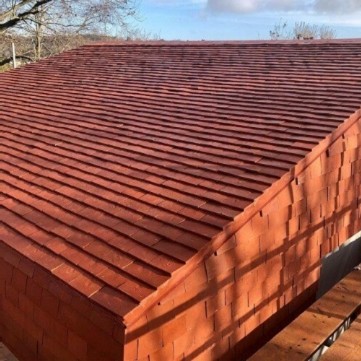Conservation Roof Tiles in Buckinghamshire
Heritage Tiles: Emblematic of the finest craftsmanship
Heritage tiles are the professional roofer's choice for the highest quality clay roof tiles. We pride ourselves in manufacturing, stocking, and delivering the very finest in prestige clay roof tiles.
Heritage Tiles have several tile ranges that satisfy every architectural requirement. Vintage and historic properties right up to modern new builds are covered by the diverse range of clay roof tiles that we stock.
So, whether you are in the building trade, or simply wish to choose your own tiles, Heritage Tiles have the right product for your specific requirements.
What Heritage Tiles have to offer our customers?
- We offer specification and technical solutions to help you achieve the perfect build.
- We also offer expert design advice to all our customers.
- We are happy to engage in site visits with our clients.
- We have stockists and distributors throughout the United Kingdom to ensure that we can provide our expert service to a wider area.
- We can provide estimated quantities from plans supplied by our clients.
- We offer battening plans.
- We can deliver a standard and bespoke colour choice for our clay tile products.
- All our tiles are assessed and approved by Lucideon.
- We provide a nationwide delivery and collection service.
The ranges of clay roof tiles we supply.
The Clayhall Range of roof tiles:

Clayhall Medium Blend - Carefully crafted to replicate all the features of handmade the Clayhall hand crafted range of tiles offers an excellent alternative when budget restrictions are a concern, but without compromising quality or durability.
Clayhall Dark Blend - Quality and durability in a budget clay roof tile. The Clayhall dark blend is sure to turn heads.
Clayhall Red Blend - A beautiful rustic clay roof tile. The Clayhall red blend is a firm favourite with our customers.
Clayhall Hamlet Mix - The Clayhall Hamlet mix is a gorgeous light and sandy looking clay roof tile that is a perennial favourite in the building trade.
Clayhall Birchwood Mix - The Clayhall Birchwood mix offers a gorgeous blend of lighter and darker shades in this diverse clay roof tile. If you are concerned that your roof tiles could look monotonous, the Clayhall Birchwood mix is the clay roof tile to choose.
The Conservation Range of roof tiles

The Conservation range of roof tiles are available in a range of distinctive colours, created by using a very fine sand, The Conservation Weathered; A natural warm tone, achieving an instant mellow and settled look and The Conservation Red; perfect for vertical tiling especially suited for villages and hamlets with olde world vernacular charm.
Manufactured using high quality clay, achieving high strength and durability properties, giving homeowners and contractors peace of mind for many years to come. The conservation range comes with a complete set of associated fittings, including Hog Back Ridge, Half Round Ridge, Bonnet Hips, Valley tiles and External Angles.
The Conservation range of clay roof tiles comes in the following variations:
- Conservation Red
- Conservation Weathered
- Conservation Dark
Conservation Peg Tile
Plain clay roofing tiles laid to a double lap have been used for roof covering in England since before the Norman Conquest and tiles dating back to Roman Times have been discovered under excavation. From the outset clay plain tiles were made incorporating fixing features.
The Classic Edwardian roof tile
The Classic range of plain tiles is one of the finest ranges of clay tiles.
We source only the best raw materials for our craftsman to create beautifully handmade clay tiles of the highest quality and durability.
Tile Fittings available from Heritage Tiles
There are many fittings that are available from us a Heritage Tiles to complete your build to perfection. We stock and supply the following:
- Gable Tile
- Eave Tile
- Baby Porch Ridge
- 90 Degree Ext. Angle
- Universal Bonnet Hip
- Half Round Ridge
- Hogs Back Ridge
- Mono Ridge
- Third Round Ridge
- Universal Valley
- Ornamental Club
- Bat Tile Set
Bat Tiles:
Provide help for our bats with our range of bat friendly roof tiles.
Did you know that all UK bats and their roosts are protected by law? The Wildlife and Countryside Act introduced in 1981, gave legal protection to all bat species and their roosts in England.
Distinct species of bats prefer differing places to roost. The two most usually found species of bat in the UK are the Pipistrelle and Brown Long-Eared Bat. Pipistrelle prefer confined spaces such as under tiles on roofs and hanging spaces. The Brown Long-Eared Bat prefer roof timbers and ridges inside lofts. Heritage Clay Tiles can provide purpose made access points within your roof tiles or ridge tiles. The Bat Tile Set can form part of a mitigation package required by law for existing roosts or as potential access where a roost had not previously been present.
Select a Blend
Getting the right blend for your roofing project can feel daunting, but with our blend generator you can mix and match various blends of tiles to achieve the perfect blend.
Click here to make use of our online tool to choose your own unique blend.
Because our strict quality control provides a consistent tile size you can mix assorted styles and colours of tiles to make your roof unique to you. Please use the tool below to experiment with various blends.
Adjust the sliders to set the ingredients for your desired blend then click on the update mix button.
Alternatively click on any blend or tile to display it.
Whatever type of clay roof tile you want, Heritage Tiles will be able to help.
Conservation Roof Tiles
Conservation roof tiles in a dark finish
The conservation roof tiles in a dark finish remain a firm favourite with our customers.
The beautifully darker hues that are present in our conservation roof tiles lend themselves perfectly to so many different applications. The conservation roof tiles can be perfectly at home on the main roof or vertically hung on the side of a building or a bay window.
The gorgeous darker hues of this conservation roof tile looks particularly good on the more rustic properties. Farm houses in particular are often clad in these attractive roof tiles.
A darker conservation roof tile
Although none of our conservation roof tiles are bright in colour, some customers just desire a darker hue to their handmade roof tile.
Like our red and weathered conservation roof tiles, the dark version is just as beautiful and robust.
The dark conservation roof tiles are handmade, incredibly durable and carry a fifty year guarantee for your added peace of mind.
The dark conservation roof tiles have a very pleasing fine sandy texture that will make any property stand out from the crowd.
Increase your curb appeal with dark conservation roof tiles
A new roof clad in dark conservation roof tiles can dramatically change the appearance of your home. Over time, roofing materials can fade, become discoloured, or show signs of wear and tear. A fresh, new roof brings a clean, look to your home, making it stand out from other properties in the vicinity.
A new roof covered in dark conservation roof tiles can significantly increase your home's market value. Potential buyers often see a new roof as a major selling point, as it means one less expense they will have to worry about in the future. Homeowners can expect to recoup a substantial portion of their roofing investment when they sell their home. This makes a new roof not only a practical upgrade but also a very sound financial decision.
A new roof will also provide far better protection against the elements than an old one. Our dark conservation roof tiles are resistant to wind, rain, hail, and other weather conditions that batter properties, particularly here in the United Kingdom, ensuring your home stays safe and dry. This improved durability can give you peace of mind, knowing that your roof can withstand harsh weather and protect your home from potential water damage, leaks, and structural issues.
So, if you are in the market for a new roof, consider the dark conservation roof tiles as the perfect way of achieving a high quality roof that will not only look amazing, add to your properties curb appeal, but last for generation.
A little information about Buckinghamshire
High Wycombe in Buckinghamshire
The Buckinghamshire town once had a Roman villa which has been excavated three times, most recently in 1954. Mosaics and a bathhouse were unearthed at the site on what is now the Rye parkland. The name Wycombe would appear to come from the river Wye and the old English word for a wooded valley, "combe", but according to the Oxford English Dictionary of Place-Names the name, which was first recorded in 799-802 as "Wichama", is more likely to be Old English "wic" and the plural of Old English "ham", and probably means "dwellings"; the name of the river was a late back-formation. Wycombe appears in the Domesday Book of 1086 and was noted for having six mills.
The existence of a settlement at High Wycombe was first recorded as 'Wicumun' in 970. The parish church was consecrated by Wulfstan, the visiting Bishop of Worcester, in 1086. The town was described as a borough from at least the 1180s, and built its first moot hall in 1226, with a market hall being built later in 1476.
Buckinghamshire mill trade was strong in High Wycombe
The Buckinghamshire town remained a mill town through Medieval and Tudor times, manufacturing lace and linen cloth. It was also a stopping point on the way from Oxford to London, with many travellers staying in the town's taverns and inns. The journey would have been fraught with danger, as footpads and other villains carried out their illegal activities along this busy route
The paper industry was notable in 17th and 18th century High Wycombe. The Wye's waters were rich in chalk, and therefore ideal for bleaching paper pulp. The paper industry was soon to be overtaken by the cloth industry.
The Buckinghamshire town's most famous industry was furniture, with particularly attention going to the Windsor chairs that were built in the town. Many terraced workers' houses were built to the east and west of town to accommodate those working in the furniture factories. In 1875, it was estimated that there were nearly five thousand chairs made per day in High Wycombe. When Queen Victoria visited the Buckinghamshire town in 1877, the council organised an arch of chairs to be erected over the High Street, with the words "Long live the Queen" printed boldly across the arch for the Queen to pass under. Wycombe Museum includes many examples of locally made chairs and information on the local furniture and lace industries.
The Buckinghamshire town takes an downturn
By the 1920s, many of the housing areas of Wycombe had aged badly and decayed into slums. A clearance scheme was initiated by Buckinghamshire council in 1932, whereby many areas were completely demolished and the residents rehoused in new estates that were situated above the town on the valley slopes. Some of the districts that were demolished were in a very poor state of repair, with one such area being Newland, where most of the houses were condemned as unfit for human habitation. However, some areas such as St. Mary's Street contained beautiful old buildings with fine examples of 18th and 19th century architecture. The new houses lifted the area and made it desirable to live in once again.
The RAF in Buckinghamshire
From 1940 to 1968 High Wycombe was the seat of the RAF Bomber Command. Moreover, during the Second World War, from May 1942 to July 1945, the U.S. Army Air Force's 8th Air Force Bomber Command, codenamed "Pinetree", was based at a former girls' school at High Wycombe. This formally became Headquarters, 8th Air Force, on 22 February 1944.
In the 1960s the Buckinghamshire town centre was redeveloped. This involved culverting the River Wye under concrete and demolishing most of the old buildings in Wycombe's town centre. Two shopping centres were built along with many new multi-storey car parks, office blocks, flyovers and roundabouts. To this day however, the hill that leads down into the Buckinghamshire town of High Wycombe remains incredibly steep and has led to some of the more faint hearted motorists refusing to drive down to the centre of town.
Products available from Heritage Clay Tiles Ltd in East Sussex
Clay Roof Tiles in East Sussex
Clayhall Roof Tiles in East Sussex
Conservation Roof Tiles in East Sussex
Edwardian Roof Tiles in East Sussex
Victorian Roof Tiles in East Sussex
Georgian Roof Tiles in East Sussex
Handmade Clay Tiles in East Sussex
Handmade Roof Tiles in East Sussex
High Quality Roof Tiles in East Sussex
Traditional clay tiles in East Sussex
Traditional roof tiles in East Sussex
Products available from Heritage Clay Tiles Ltd in Essex
Conservation Roof Tiles in Essex
High Quality Roof Tiles in Essex
Traditional clay tiles in Essex
Traditional roof tiles in Essex
Products available from Heritage Clay Tiles Ltd in Hampshire
Clayhall Roof Tiles in Hampshire
Conservation Roof Tiles in Hampshire
Edwardian Roof Tiles in Hampshire
Victorian Roof Tiles in Hampshire
Georgian Roof Tiles in Hampshire
Handmade Clay Tiles in Hampshire
Handmade Roof Tiles in Hampshire
High Quality Roof Tiles in Hampshire
Traditional clay tiles in Hampshire
Traditional roof tiles in Hampshire
Products available from Heritage Clay Tiles Ltd in Hertfordshire
Clay Roof Tiles in Hertfordshire
Clayhall Roof Tiles in Hertfordshire
Conservation Roof Tiles in Hertfordshire
Edwardian Roof Tiles in Hertfordshire
Victorian Roof Tiles in Hertfordshire
Georgian Roof Tiles in Hertfordshire
Handmade Clay Tiles in Hertfordshire
Handmade Roof Tiles in Hertfordshire
High Quality Roof Tiles in Hertfordshire
Traditional clay tiles in Hertfordshire
Traditional roof tiles in Hertfordshire
Products available from Heritage Clay Tiles Ltd in Kent
Conservation Roof Tiles in Kent
High Quality Roof Tiles in Kent
Traditional clay tiles in Kent
Traditional roof tiles in Kent
Products available from Heritage Clay Tiles Ltd in London
Conservation Roof Tiles in London
Edwardian Roof Tiles in London
Victorian Roof Tiles in London
High Quality Roof Tiles in London
Traditional clay tiles in London
Traditional roof tiles in London
Products available from Heritage Clay Tiles Ltd in Surrey
Conservation Roof Tiles in Surrey
Edwardian Roof Tiles in Surrey
Victorian Roof Tiles in Surrey
High Quality Roof Tiles in Surrey
Traditional clay tiles in Surrey
Traditional roof tiles in Surrey
Products available from Heritage Clay Tiles Ltd in West Sussex
Clay Roof Tiles in West Sussex
Clayhall Roof Tiles in West Sussex
Conservation Roof Tiles in West Sussex
Edwardian Roof Tiles in West Sussex
Victorian Roof Tiles in West Sussex
Georgian Roof Tiles in West Sussex
Handmade Clay Tiles in West Sussex
Handmade Roof Tiles in West Sussex
High Quality Roof Tiles in West Sussex
Traditional clay tiles in West Sussex
Traditional roof tiles in West Sussex
Products available from Heritage Clay Tiles Ltd in Bedfordshire
Clay Roof Tiles in Bedfordshire
Clayhall Roof Tiles in Bedfordshire
Conservation Roof Tiles in Bedfordshire
Edwardian Roof Tiles in Bedfordshire
Victorian Roof Tiles in Bedfordshire
Georgian Roof Tiles in Bedfordshire
Handmade Clay Tiles in Bedfordshire
Handmade Roof Tiles in Bedfordshire
High Quality Roof Tiles in Bedfordshire
Traditional clay tiles in Bedfordshire
Traditional roof tiles in Bedfordshire
Products available from Heritage Clay Tiles Ltd in Berkshire
Clayhall Roof Tiles in Berkshire
Conservation Roof Tiles in Berkshire
Edwardian Roof Tiles in Berkshire
Victorian Roof Tiles in Berkshire
Georgian Roof Tiles in Berkshire
Handmade Clay Tiles in Berkshire
Handmade Roof Tiles in Berkshire
High Quality Roof Tiles in Berkshire
Traditional clay tiles in Berkshire
Traditional roof tiles in Berkshire
Products available from Heritage Clay Tiles Ltd in Buckinghamshire
Clay Roof Tiles in Buckinghamshire
Clayhall Roof Tiles in Buckinghamshire
Edwardian Roof Tiles in Buckinghamshire
Victorian Roof Tiles in Buckinghamshire
Georgian Roof Tiles in Buckinghamshire
Handmade Clay Tiles in Buckinghamshire
Handmade Roof Tiles in Buckinghamshire
High Quality Roof Tiles in Buckinghamshire
Traditional clay tiles in Buckinghamshire
Traditional roof tiles in Buckinghamshire
Products available from Heritage Clay Tiles Ltd in Cambridgeshire
Clay Roof Tiles in Cambridgeshire
Clayhall Roof Tiles in Cambridgeshire
Conservation Roof Tiles in Cambridgeshire
Edwardian Roof Tiles in Cambridgeshire
Victorian Roof Tiles in Cambridgeshire
Georgian Roof Tiles in Cambridgeshire
Handmade Clay Tiles in Cambridgeshire
Handmade Roof Tiles in Cambridgeshire
High Quality Roof Tiles in Cambridgeshire
Traditional clay tiles in Cambridgeshire
Traditional roof tiles in Cambridgeshire
Products available from Heritage Clay Tiles Ltd in Oxfordshire
Clay Roof Tiles in Oxfordshire
Clayhall Roof Tiles in Oxfordshire
Conservation Roof Tiles in Oxfordshire
Edwardian Roof Tiles in Oxfordshire
Victorian Roof Tiles in Oxfordshire
Georgian Roof Tiles in Oxfordshire
Handmade Clay Tiles in Oxfordshire
Handmade Roof Tiles in Oxfordshire
High Quality Roof Tiles in Oxfordshire
Traditional clay tiles in Oxfordshire
Traditional roof tiles in Oxfordshire
Products available from Heritage Clay Tiles Ltd in Suffolk
Clayhall Roof Tiles in Suffolk
Conservation Roof Tiles in Suffolk
Edwardian Roof Tiles in Suffolk
Victorian Roof Tiles in Suffolk
Georgian Roof Tiles in Suffolk
Handmade Clay Tiles in Suffolk
Handmade Roof Tiles in Suffolk
High Quality Roof Tiles in Suffolk
Traditional clay tiles in Suffolk
Traditional roof tiles in Suffolk
Further Information
If you would like to know more or are interested in a quote we would be happy to help. Phone us on 01634 471 344, email us at sales@heritagetiles.co.uk and we will be in touch as soon as possible.







